
views
Planting Centipede Grass Seeds or Plugs

Use either seeds or plugs for a lower cost, but more labor. Centipede grass seed and plugs are extremely inexpensive, making them both attractive options. However, since you’ll be starting from scratch, you’ll need to put in a lot of work to make sure the grass is established. These processes will both take at least 3-4 weeks to complete, so they’ll also be more time-intensive than sod, your other planting option.
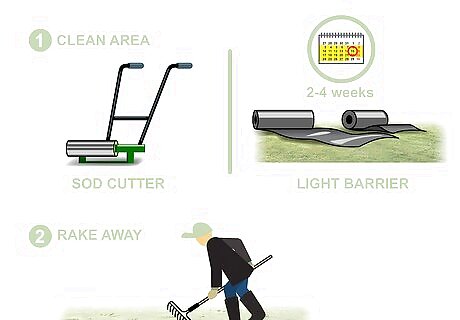
Make sure the area is clear of any other grass. If you’re replanting an existing lawn, either tear out the existing grass with a sod cutter or apply a non-selective weed killer to the whole area. Cover the area with a light barrier, such as a tarp, and wait 2-4 weeks. This will kill the old grass and prevent it from re-establishing itself when you plant the centipede grass. Make sure to rake away all of the leftover dead grass before you start tilling.
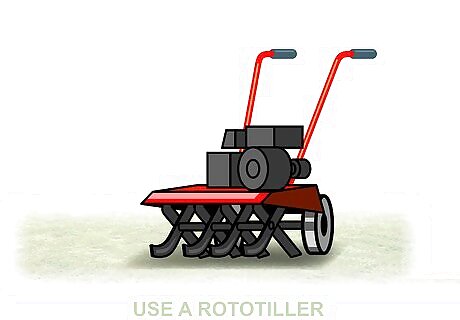
Till the area where you’ll be planting the grass. Use a rototiller and work in straight, even lines to loosen and aerate the soil. Till to a depth of about 5 inches (13 cm) to improve your soil quality. If you don’t have a rototiller, you can rent one from garden stores or home improvement stores for around $45 per day. However, the price may vary depending where you live.

Use a rake or roller to the level the soil. Push the loosened soil around the area until it lays level. This will ensure good seed-to-soil contact and help the grass grow evenly.

Spread the grass over the area with a spreader if you’re using seed. Pour the seed into the spreader and walk it around the area in even rows. Generally, you should spread 1 pound (0.45 kg) of centipede grass seed per 3,000 square feet (280 m) of soil. However, this measurement may vary based on your location and climate, so always follow the instructions that come with the grass seed. To improve the seed’s efficiency and make it easier to spread, mix in 3 gallons (11 L) of sand with every 1 pound (0.45 kg) of grass seed before spreading it. If you don’t have a spreader, you can rent one from a home improvement store.
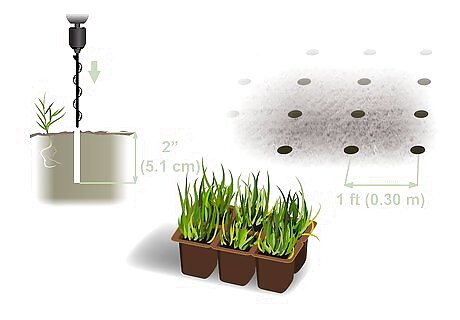
Insert grass with a sod plug drill bit if you’re using plugs. Drill directly into the ground, keeping approximately 1 ft (0.30 m) of space between each plug. The grass plugs will reach about 2 in (5.1 cm) into the ground. You can purchase grass plugs from a nursery, at a local garden center, or over the internet. Alternatively, grass plugs can also be planted by hand. Dig a shallow hole with a hand trowel and place the plug in the hole, covering the roots completely with soil. This is a good option if your lawn is small and you don’t mind doing a little gardening yourself.
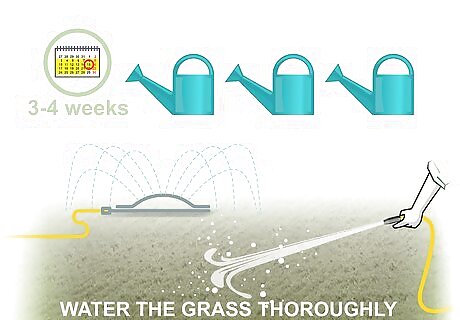
Water the grass thoroughly for 3 weeks so it can form strong roots. The grass will need lots of water for its first few formative weeks, starting with right after you finish planting. Give it a healthy watering, and keep it well-watered daily until the 3 weeks are up. After that, your grass should only need water during a drought, when it shows signs of water stress.

Avoid stepping on the grass for the first 3 weeks. While the grass is still growing and developing its root system, leave as undisturbed as possible. Let family members or visitors know that the grass shouldn’t be walked on while it’s still new.
Laying Down Centipede Grass Sod
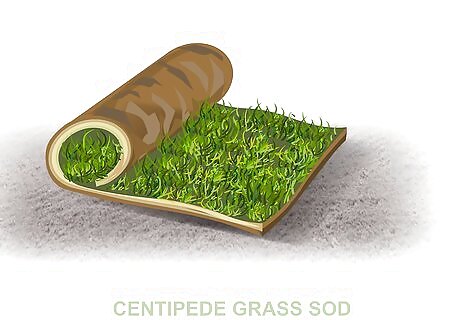
Choose this method if you want to pay more for less labor. Sod is the most expensive option, but it’s also the fastest and easiest. If you’re looking for a quick and low-labor lawn, this is your best option.

Remove any existing grass in the area. If you’re replanting an existing lawn, you’ll need to kill the old grass by applying weed killer or tearing it out with a sod cutter. Then, cover the ground with a lightweight barrier, such as a tarp, for 2-4 weeks. Covering the area after removing the old grass will ensure that it won’t re-establish itself when you replant your lawn. When you remove the tarp, rake away all of the leftover dead grass. Bag it and dispose of it in a yard waste container.

Use a spreader to cover the area in nitrogen-rich fertilizer. Sod needs additional nutrients in order to establish, so it’s important to condition the top layer of soil. Walk the spreader around in straight, even lines and lay down 20 lb (9.1 kg) of 5-10-5 starter fertilizer for every 1,000 square feet (93 m) of lawn. If you don’t have a spreader, you can rent one from a home improvement store.
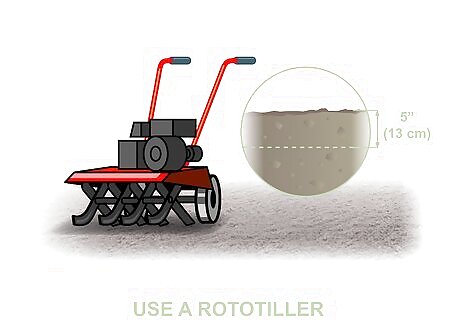
Till the whole area to improve the soil quality. Immediately after laying down the nitrogen-rich fertilizer, run the rototiller over the area to mix and aerate the soil. Combine the fertilizer with the soil by tilling the top 5 inches (13 cm) of the soil. If you don’t have one, you can rent a tiller from a garden or home improvement store.
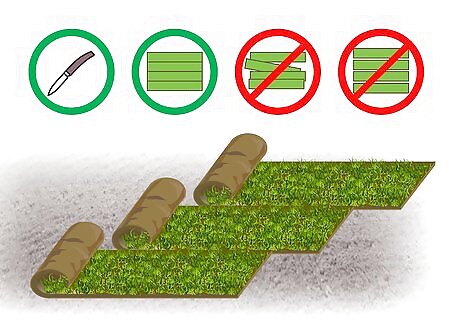
Lay the sod down so the edges touch but don’t overlap. This will prevent the edges from drying and seams from showing in the lawn. The sod pieces will also knit together more neatly. Use a knife to cut around any edges, such as planting beds or paved areas, or to cut out holes for sprinkler heads.
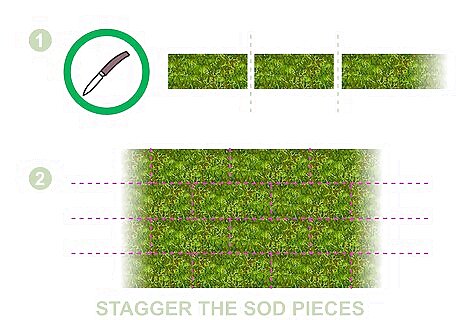
Stagger the sod pieces so they can form a stronger network. Lay the sod directly onto the soil like you would lay bricks, in long rows with the seams staggered. You can also use a knife to cut pieces in half, then alternate between long and short pieces to create a more staggered effect.

Water the sod thoroughly for 3-4 weeks. Start watering right after you lay and roll the sod, and continue watering it well for the first month or so while it establishes roots. Watering every day, preferably in the morning, also helps the soil settle and bond. Watering at night increases the grass’s chance of fungal infection, so try to water during the morning or early afternoon.
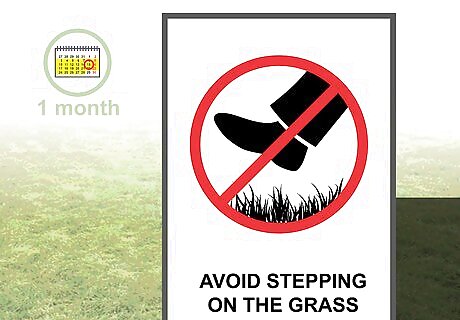
Don’t step on the sod for 1 month to give it time to settle. Avoid disturbing the sod while it grows together and forms roots. You can either rope off the area or let family members know that they’ll need to stay off the grass until it’s healthy and strong enough to be stepped on.
Caring for Your Centipede Grass

Spread a nitrogen-rich fertilizer over your grass twice a year. You’ll need to apply the fertilizer once in the spring and once in the fall. Make sure to lightly apply a thin layer of the fertilizer, since too much can damage the grass. Only use 1 pound (0.45 kg) per 1,000 square feet (93 m) of land each time you apply it. Look for fertilizers with high amounts of nitrogen and potassium to , and little to no phosphorous, such as one with a 15-0-15 nutrient ratio. If you live in an area with cold winters, wait until there is no chance of frost before applying the fertilizer. Mix the fertilizer into your soil following the manufacturer’s directions on the bag or container.

Water the grass only when it looks wilted or loses color. Centipede grass only needs watering during drought, when it starts to show signs of water stress. If you notice these qualities, water it once a week deeply. Deep watering encourages deep roots, while shallow watering a few times a week encourages shallow, stress-susceptible roots.

Mow your centipede grass to a height between 1 to 2 in (2.5 to 5.1 cm). Generally, you should try to keep your centipede grass at 1 in (2.5 cm). However, if you see any scalping in areas, you can raise the height to 1.5 to 2 in (3.8 to 5.1 cm), but never over 2 in (5.1 cm). Scalping occurs when the grass is cut too short, exposing the dirt beneath. You should always mow when the grass is 1 in (2.5 cm) over your desired height. For example, if you want 2 in (5.1 cm) grass, you should mow whenever the grass reaches 3 in (7.6 cm).


















Comments
0 comment